In case you missed this lovely article on one of CHIRI’s rising stars, recently published in The West Australian ……
In this special Science on the Swan edition, we profile some of the brightest up-and-coming West Australian researchers and the exciting work they are doing.
Ramsay laboratory, School of Biomedical Sciences and Curtin Health Innovation Research Institute, Curtin University Bacterial gene exchange and the evolution of antibiotic-resistant bacteria. Antibiotic resistance, one of the greatest health challenges of our time, is assisted by the fact that bacteria are able to evolve rapidly and directly share their DNA with each other through a process known as horizontal gene transfer.The pieces of DNA they share, called mobile genetic elements, act as vehicles for the transfer of antibiotic resistance genes, converting antibiotic-sensitive strains into resistant strains in a single step.
Most worrying is that these mobile genetic elements often carry multiple resistance genes for multiple antibiotics, so their transfer rapidly produces multiresistant superbugs that can’t be controlled by most available antibiotics, according to Dr Ramsay.
“Bacterial infections are usually effectively treated using antibiotics that target and kill bacteria but we are increasingly being colonised by bacteria that are completely resistant to the effects of antibiotics,” he said.
Dr Ramsay is studying these mobile genetic elements and the process of horizontal gene transfer at a molecular and genetic level with the ultimate goal of identifying strategies to reduce, inhibit or prevent horizontal gene transfer and prolong the effectiveness of current and future antibiotics.
